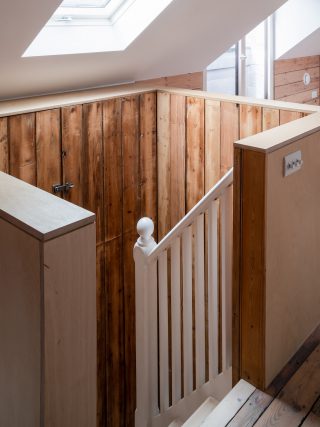Sanya Polescuk Architects has skilfully inserted a pair of low-carbon, multi-generational flats into a Victorian mews in north London, significantly boosting the building’s spatial and environmental performance.
Sanya Polescuk Architects (SPA) has a reputation for breathing new life into old buildings, while simultaneously minimising their carbon footprint. The practice’s latest project in this vein inserts a pair of low-carbon, multi-generational flats into a Victorian mews building in London’s Belsize Park. Located close to SPA’s own studio, the project provided an opportunity for the practice to review its approach to projects of this type. The resulting scheme not only utilises more reclaimed materials and recycled content, but also improves energy efficiency over previous developments.
Originally comprising stables with staff accommodation above, the mid-terrace mews building had been partially converted into a house in the 1980s. It included an uninsulated attic, an open garage/store room on the ground floor, and several bathrooms located throughout the plan.
The brief was for an efficient, future-proof pair of self-contained homes with a breakthrough spot to inter-connect them in the future. Above the single-bedroom ground-floor flat, the first occupants of the ‘upside-down’ four-bedroom maisonette are refugees fleeing conflict.
The project features a range of passive and active environmental technologies. A whole-house MVHR system has been installed, and the architect says that the project’s heat pump-ready design will facilitate the transition away from gas when public acceptance allows for heat pumps in conservation areas.
Landfill and embodied carbon have been reduced by salvaging, restoring and reusing many building elements found on site, as well as applying recycled materials and limiting the use of cement. Timber boarding discovered within the plasterboard walls has been reused as cladding around the existing winder staircase that leads to the loft. The less good floorboards have been turned 90 degrees and used as cladding for the low loft walls. Elsewhere, the roof ties are exposed to sit alongside the reclaimed timberwork.
The building envelope is fully insulated and sealed with taped OSB-lined walls. Instead of UFH cast into a screed, thin pre-grooved rigid panels float directly on the thick floor insulation. A restrained palette of materials includes terrazzo tiling with 40 per cent recycled porcelain, and recycled yoghurt pot boards as kitchen units and worktops.
Externally, weepholes provide independent ventilation for the existing brickwork. The boat-like open-plan cooking/living space on the top floor has been roofed with reclaimed slates, and has solar hot water panels recessed into the south-facing pitch and a pair of heavily insulated modern dormers set into the north side. Appearing identical from the street, one dormer hides a full-height French door by the sitting area, while the other, conceals a smaller window with a herb garden by the kitchen. The openings are carefully calibrated to maximise light from the north and south.
The retained Victorian windows have been rehung and re-fitted with extra-slim double-glazing and new seals. The old stable doors have been restored with newly-made hinges produced from the original castings. Behind the doors, new triple-glazed windows and doors complete the thermally-efficient building envelope, while also maximising daylighting.






























